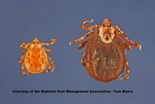Need assistance? Call 800.996.4402

The American dog tick gets its name from the fact that adult ticks prefer domestic dogs as hosts, and this tick species is only found in North America.
It is thought that American dog ticks are attracted by the scent of animals, so they are common along roads and trails. Adult ticks prefer domestic dogs as hosts and can therefore be brought into the home and potentially transferred to humans.
The American dog tick is the primary vector of Rocky Mountain spotted fever in the United States. It is also known to transmit tularemia, a rare bacterial infection, and cause tick paralysis.
These ticks prefer grassy areas with low vegetation where larger mammals pass by. American dog ticks do not survive well indoors.
When in an area where ticks are common, wear long sleeved shirts and pants, preferably light colored so ticks will be easy to detect. Tuck pants into socks, and use a tick repellent when outside. To get rid of ticks and limit risks indoors, inspect clothing and skin when heading inside. Wash clothes immediately.
If a tick is found on the body, use fine-tipped tweezers to grasp it as close to the skin’s surface as possible. Pull upward with steady, even pressure. Don’t twist or jerk the tick as this can cause the mouth-parts to break off and remain in the skin. Once the tick is removed, thoroughly clean the bite site with soap and water. Then, flush the tick down the toilet or wrap it in a tissue before disposing in a closed receptacle.
For the very best food safety consulting, auditing and training, please visit our strategic partner, CFS Food Safety